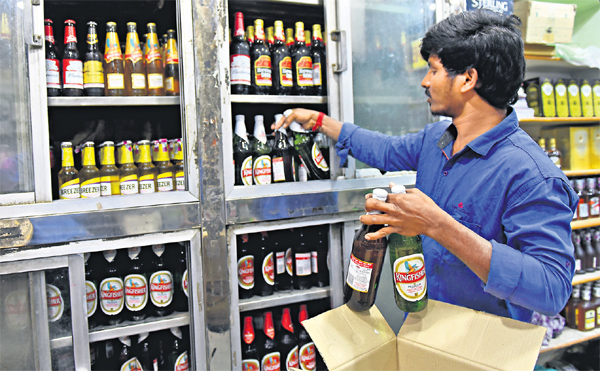As the revenue of the states falls due to Coronavirus lockdown, the union government has allowed the states to open liquor shops in all areas except the containment zones. “Sale of liquor, paan, tobacco to be allowed after ensuring minimum six-feet social distancing; not more than five persons at one time at shop,” guidelines issued by the Union Ministry of Home Affairs said.
The union government has extended lockdown for two weeks but liquor, tobacco products like Cigarette and bidi shops are allowed to open in all zones- Red, Orange, Green- except the containment zones. These products, usually called ‘sin goods’ are a major source of revenue for state governments.
The total revenue from liquor is around 2.5 Lakh Crore rupees for all states combined, and the revenue from tobacco products is around 50,000 crore rupees. The total revenue from ‘sin goods’ is around 3 lakh crore rupees.
Liquor is a major source of revenue for all states except the dry ones like Gujarat. For most of the states, revenue from liquor accounts for around 20-30 per cent of their own yearly tax revenues, and therefore, states were desperate to open the liquor and tobacco shops.
Last year, the revenue of Chhattisgarh government from excise of liquor sale was more than 5,000 crore rupees, or, around 25 per cent of the state’s own tax revenues (22,000 crore rupees). And for Kerala, the alcohol consumption contributes around 12,000 crore rupees to the tax kitty, 20 per cent of the total. For any state, two of the largest sources of tax revenue which are under their control are- Petroleum (Petrol and diesel) and Alcohol.
The state rushed to open the liquor shops after the Union government allowed reopening. Even the Union territories like Delhi, which have a very high number of Covid-19 cases, asked the state-run agencies-Delhi State Civil Supplies Corporation Limited (DSCSCL) Delhi Consumer’s Cooperative Wholesale Store Limited (DCCWSL), Delhi State Industrial and Infrastructure Development Corporation (DSIIDC) and Delhi Tourism and Transportation Development Corporation (DTTDC) – to prepare a list of L6 (Indian made foreign liquor-IMFL) and L8 (country liquor) for retail sale.
In the last few years, the states have become increasingly dependent on alcohol and petroleum tax for their own revenue. “Liquor provides 20 per cent of the share of the government’s own revenue in most States,” says Jose Sebastian, associate professor at Gulati Institute of Finance and Taxation, Thiruvananthapuram.
“State governments’ dependence on alcohol revenue is very unhealthy and disproportionate,” says K.K. George, chairman of the Kochi-based Centre for Socio-Economic and Environmental Studies. “This imbalance needs to be corrected.”
If we take a look at the big picture, the total revenue from sin goods- alcohol and tobacco products- is more than the total personal income tax collection of individuals. Total Income Tax collection is around 4.3 lakh crore rupees for last year but around 30 per cent of this comes from sole proprietorship businesses which file Income tax rather than a corporate tax. Therefore, if we count only individual income tax collection, it is less than the total taxes paid by sin good consumers.
Closure of alcohol shops means that the losing around 25 per cent of total own tax collection, and at a time when collection from petroleum has dipped near zero due to pandemic induced lockdown, liquor excise is the lifeline for the states. This is also the reason that the leaders promise complete alcohol ban in many states, but when they come to power, the idea is thrown into the dustbin, as seen in the case of Chhattisgarh.
